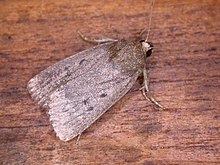
The garden dart is a moth of the family Noctuidae. It is distributed throughout much of the Palearctic. Temperate regions of Europe, Central Asia and North Asia, as well as the mountains of North Africa. Absent from polar regions, on Iceland and some Mediterranean islands, as well as in Macaronesia.

The square-spot rustic is a moth of the family Noctuidae. It is found in Europe, North Africa and east across the Palearctic and in North America.

The bright-line brown-eye is a moth of the family Noctuidae. The species was first described by Carl Linnaeus in his 1758 10th edition of Systema Naturae. It is a common species throughout Europe, but is also found in North Africa, temperate North Asia and Central Asia, Asia Minor, Syria, and Turkestan, northern India, China, Korea and Japan.

The common Quaker is a moth of the family Noctuidae first described by Johan Christian Fabricius in 1775. Some authors prefer the synonym Orthosia stabilis(Denis & Schiffermüller, 1775). It is distributed throughout Europe and is also found in Turkey, Israel, Transcaucasia, Russia and eastern Siberia.

The minor shoulder-knot is a moth of the family Noctuidae. The species was first described by Johan Christian Fabricius in 1776. It is distributed throughout Europe then east across the Palearctic to Siberia and Japan. It also occurs in Turkey.
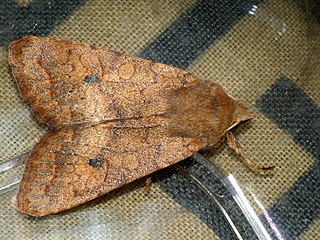
Agrochola circellaris, or The Brick, is a species of moth of the family Noctuidae. The species was first described by Johann Siegfried Hufnagel in 1766. It is distributed throughout most of Europe, Asia Minor and Armenia.

The lunar underwing is a moth of the family Noctuidae. The species was first described by Adrian Hardy Haworth in 1809. It has a scattered distribution in western Europe including Spain, Scandinavia and Algeria.

The angle shades is a moth of the family Noctuidae. The species was first described by Carl Linnaeus in his 1758 10th edition of Systema Naturae. It is distributed throughout Europe as far east as the Urals and also in the Azores, in Algeria, and in Asia Minor, Armenia, and Syria. It is strongly migratory.

The straw underwing is a moth of the family Noctuidae. The species was first described by Johann Siegfried Hufnagel in 1766. It is found from North Africa west through South Europe and Central Europe. In the north it is in parts of Ireland, Scotland, Sweden, Norway, Finland and Estonia. Further east the range stretches from southern Russia and Asia minor to the Caucasus.

Apamea crenata, known as the clouded-bordered brindle, is a moth in the family Noctuidae. It is distributed throughout the Palearctic realm. In the North it crosses the Arctic Circle, in the Mediterranean it is found only in cool locations and mountains avoiding very hot areas. In the Alps, it rises to an altitude of about 2000 metres.

Apamea remissa, the dusky brocade, is a species of moth of the family Noctuidae. It is distributed throughout Europe and Turkey, ranging across the Palearctic realm to Siberia, Manchuria and Japan. It has also been reported from Alaska.

Apamea sordens, the rustic shoulder-knot or bordered apamea, is a moth of the family Noctuidae. The species was first described by Johann Siegfried Hufnagel in 1766. It is distributed throughout Europe, east across the Palearctic to Central Asia and to China and Japan. It also occurs in North America.
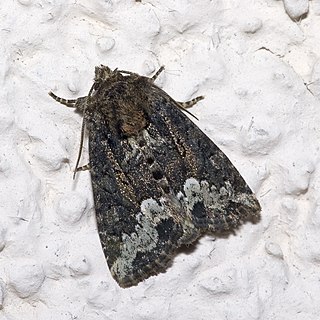
The marbled minor is a moth of the family Noctuidae. The species was first described by Carl Linnaeus in his 1758 10th edition of Systema Naturae. It is distributed throughout Europe, east through the Palearctic to central Asia and the Altai Mountains. It rises to heights of over 1500 meters in the Alps.

Mythimna albipuncta, the white-point, is a moth of the family Noctuidae. The species was first described by Michael Denis and Ignaz Schiffermüller in 1775. It is distributed throughout Europe and one subspecies is found in Tunisia. It is also found in Asia Minor, Armenia, and Iran, and the northeastern United States.

Orthosia incerta, the clouded drab, is a species of moth of the family Noctuidae, found in Europe and Asia. The occurrence of the species extends through all European countries through the Palearctic to the Russian Far East and Japan. It is absent from northern Fennoscandia and in the Alps it occurs up to 2000 m above sea level.

Atethmia centrago, the centre-barred sallow, is a moth of the family Noctuidae. The species was first described by Adrian Hardy Haworth in 1809. It is found in Europe except Scandinavia and Italy; also in Asia Minor, Armenia, Syria and Palestine.
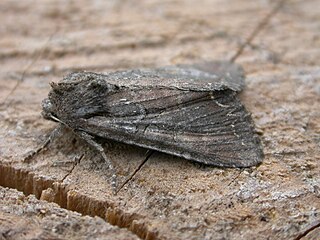
Lacanobia suasa, the dog’s tooth, is a moth of the family Noctuidae. It is found in the Palearctic realm.
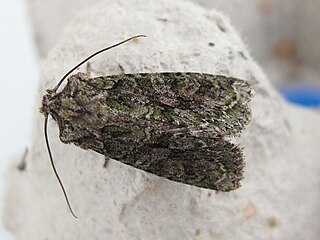
Dryobotodes eremita, the brindled green, is a moth of the family Noctuidae. The species was first described by Johan Christian Fabricius in 1775. It is found in most of Europe, east to Turkey.

Parastichtis suspecta, the suspected, is a species of moth in the family Noctuidae. It is found from most of Europe through Russia and east through the Palearctic to Japan. It is also found in North America.
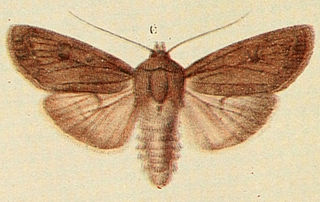
The Scarce Arches is a moth of the family Noctuidae. It is found in central and eastern Europe and in southern Scandinavia. north Germany, Russia including the Ural Mountains, west and east Turkestan. It is not known to breed in Britain, occurring only as a migrant.
